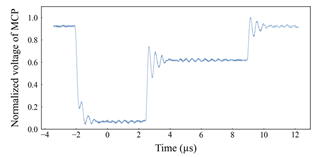Other Parts Discussed in Thread: DLPA200, DLPC410
Tool/software:
I have a few questions regarding the mirror clock pulses (MCP) that are sent to update the physical state of mirrors in each block for the DLP7000. When I measure the mirror clock pulse directly, I get the following signal:

Is there a particular reason for this two-step behavior? Does this have something to do with the mirror clock pulse shape varying based on DMD chip type as referenced in the documentation for the DLPA200 DMD Micromirror Driver?
Furthermore, the documentation for the DLPA200 mentions that "the Micromirror Clock Generation function uses the three voltages generated by the High-Voltage Power Supply function to create the sixteen micromirror clock pluses" with those three voltages being V_BIAS, V_RESET, and V_OFFSET. How exactly are they combined to produce the MCP?

